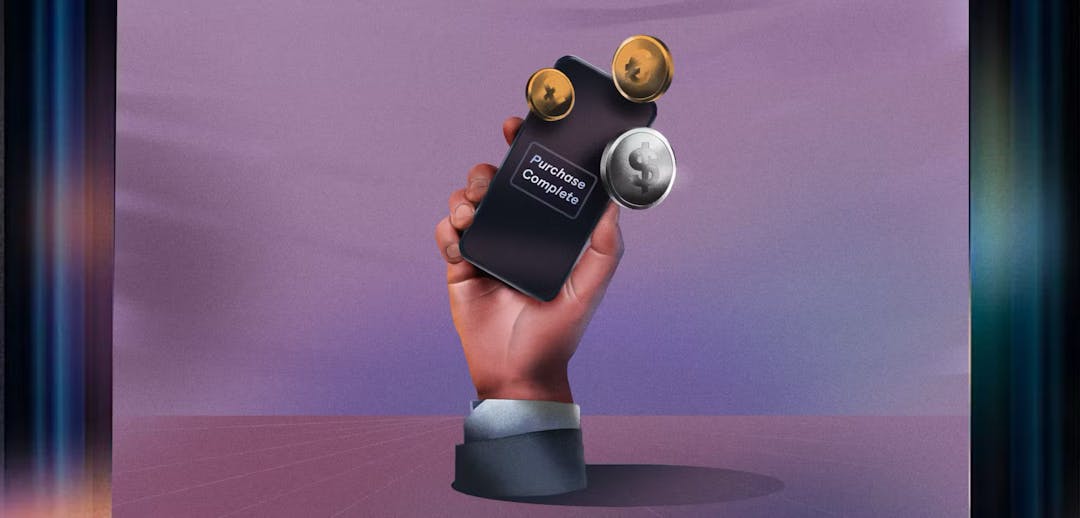You can’t fully eliminate chargebacks, but you can put the right strategies in place to minimize their impact on your bottom line. Explore how to reduce chargeback rates with Paddle.
Chargebacks are a real headache for businesses, resulting in lost revenue, additional fees, and potential reputational damage. If your business receives too many chargebacks, payment service providers (PSPs) may refuse to work with you.
That’s why it’s important to understand how to prevent and handle chargebacks when they arise. Below, we cover the basics, the causes, and how Paddle reduces chargeback by an average of 50% for new customers.
What are chargebacks?
A chargeback happens when a customer disputes a transaction through their bank and the funds get returned to their account. Customers usually do this when they think a charge was fraudulent, unauthorized, or if the product didn't meet their expectations.
The process is straightforward: the customer contacts their bank and the bank investigates. If the bank finds the dispute valid, they reverse the transaction and take the money from the merchant's account.
Imagine you made a purchase but later discovered that the product you bought was not what you expected, didn’t work, or it was a purchase you didn’t make at all. You can then dispute the charge with your bank. Your bank will initiate a chargeback process and investigate the transaction. If they agree with you, you get refunded and the merchant loses both the product and the payment.
What is a good chargeback rate?
A good chargeback rate is as close to 0 as possible. In general, a chargeback rate under 1% is considered good for most businesses. If you’re at 1% or higher, it’s likely that you’ll be considered ‘high risk’, which means card payment networks and payment processors might be hesitant to work with you, or require you to reduce your chargeback rate before they do. It’s worth noting though that chargeback rates can vary by industry and payment processor.
How to calculate your chargeback ratio
You can calculate your chargeback ratio by dividing the number of chargebacks by your total number of transactions for a given period.
For example, if your business had 1000 transactions in a month, and received 10 chargebacks during that time, your chargeback rate would be 10/1000 = 1%.
Why are high chargeback rates bad for you, as a merchant?
In the worst case scenario, a high chargeback rate could result in PSPs refusing to work with you, which could be detrimental to your business. In general, chargebacks can be a significant burden for merchants as they result in financial losses, are time-consuming, increase costs, and increase the risk of fraud:
- Financial loss. A chargeback results in a direct financial loss for you, as you have to repay the disputed amount and a chargeback fee. Fees vary by acquiring bank, from around $20-$100.
- Time-consuming. Responding to chargebacks is time-consuming as you must provide evidence for each individual dispute, pulling resources away from growing your business.
- Increased fraud. Some consumers may abuse the process to receive free products. If your fraud rates are too high it can lead to blacklisting by PSPs.
What causes chargebacks?
By understanding the causes of chargebacks, you can take steps to prevent them from happening and develop effective strategies to manage them when they do.
Here are five common causes:
- Fraudulent transactions: A customer may dispute a charge if they suspect that their card was used without their authorization, or if they believe that the transaction was fraudulent.
- Dissatisfaction with product or service: A customer might initiate a chargeback if they are unsatisfied with the product or service, or if the product was not as described.
- Technical issues: Technical issues such as website errors or glitches during the checkout process may result in duplicate charges or incorrect amounts being charged.
- Processing errors: Processing errors such as incorrect billing information or incorrect transaction amounts can also result in chargebacks.
- Subscription or recurring billing issues: Customers may forget about recurring subscription charges, or they may dispute them if they believe they weren’t adequately informed of the terms of the subscription.
Why are subscription businesses more at risk?
If your company offers a subscription product with automatic recurring billing and payments, there is a heightened risk of chargebacks coming about from either:
- Buyers who do not recognise recurring payments after an introductory offer or free trial for various reasons
- Buyers who, whilst recognising the business, did not expect to be charged a recurring payment
- Buyers who recognise the payment and know about the subscription terms but claim to their bank that they did not authorise the payment (this is commonly known as ‘friendly fraud’)
It’s important to note that all of these give rise to disputes and chargebacks from card issuers, but a large proportion of these are categorised by card issuers as ‘fraud’, which impacts a merchant’s fraud dispute rate in the standing of card brands.
How to prevent chargebacks
While it’s almost impossible to reduce chargebacks to zero, you can take steps to reduce how often they happen.
Here are six best practices from Paddle’s risk team to help you reduce chargebacks:
- Be clear in your statement descriptor. This brief descriptor appears on your customer’s bank/credit card statement. Make sure it is recognizable to your business - customers should be able to identify the purchase immediately so they don’t mistakenly initiate a chargeback. If you’re a Paddle customer, you can find more information on changing your descriptor here.
- Be transparent in your billing terms. Make sure your product pages and pricing pages have clear and obvious information. i.e. If your subscription is set to auto-renew or if your product is related to a number of licences or a set number of devices - make sure this is clear to the buyer.
- Be proactive in refunding suspicious transactions. If a payment looks fraudulent, you should issue a quick refund to avoid dispute fees, protect your chargeback rate, and prevent product loss. If you’re unsure about a transaction, refer to our tips on identifying fraud here and take the necessary action.
- Make use of our various transaction notifications. Paddle gives you the option to send a variety of notifications to assist with your buyer communication. Increased buyer communication surrounding billing will help to reduce chargebacks. Pre-Billing Notifications are a card scheme requirement for all subscriptions with a 6-month or longer billing cycle,but are also particularly effective on monthly cycles too.
- Make your refund and cancellation policies clear. Clearly communicate your refund and cancellation policies to customers at the point of sale.
- Identify and verify your customers. Use captchas or ask customers for email verification before purchase to deter fraudsters from taking advantage of your service.
Working with a Merchant of Record (MoR), like Paddle, means we can help manage chargebacks and fraud prevention for your company.
How Paddle can help you manage chargebacks
Preventing chargebacks is key to the health of your business. And as you grow, we grow, which is why Paddle has invested in various programs and technologies to reduce the number of chargebacks for merchants in our network. Our team will work closely with you to address the cause of high chargeback rates.
On average when customers sign up to Paddle, their chargeback rate halves.
Who we’ve helped
Master English - Language learning app, Master English, had a chargeback rate of 1.12% before joining Paddle. Our risk team worked closely with the company to identify the cause of chargebacks and quickly found a solution. In just 2 months, Master English had reduced their chargeback rate to 0.53% - a 54% overall reduction in chargebacks since joining Paddle.
HubX - With a portfolio of apps, HubX was finding the transition from app to web sales meant having to manage a growing number of chargebacks and disputes. Moving to Paddle’s MoR model meant that they could use Paddle’s pre-chargeback alert and fraud systems to take action against the risks of chargebacks before they occurred.
Bouncer - Email verification platform, Bouncer, found that managing chargebacks not only meant lost revenue and processing fees, but also hours of resources spent on follow-up. Joining Paddle improved Bouncer’s cash-flow predictability and freed up resources to be spent elsewhere.
Read more Paddle customer stories.
How Paddle can help you
Paddle receives pre-chargeback alerts
Pre‑chargeback alerts or pre-chargeback notifications give us an early warning when a buyer initiates a dispute, before it counts as an official chargeback. Once a buyer disputes a charge, we have around 48 hours to issue a full refund before the dispute is filed as a chargeback. A fee is still applied to cover the cost of the alert, but your chargeback rate won’t be affected.
Maintaining a low chargeback rate is really important for maintaining a good standing with payment processors and card payment networks.
Paddle helps you optimize your communications
The Paddle team offers support and advice to help you avoid chargebacks, guiding and educating you on best practices. This can include everything from explicit billing descriptors, to transparent communication, and prompt customer complaint resolution.
Our risk team will work closely with you to find a solution tailored to your company.
We sent information about our refund policy, reminding customers that we are here to offer them a great service, but, if they are not happy, we will refund them within 30 days of a transaction.”
Lauri Leinonen, Chief Marketing Officer, Master English
Paddle protects you from fraud
We leverage a combination of human expertise and technology to identify and prevent fraud before it happens. We implement a variety of fraud detection and prevention tools that help to identify high-risk transactions and take action to mitigate the risk of chargebacks.
The pre-chargeback alert and fraud systems were compelling. We liked the fact that Paddle would take on our chargeback risk.”
Kaan Ortabas, Co-Founder, HubX
Paddle fights your corner
We challenge a chargeback and provide evidence to the card issuer on your behalf to prove the transaction was valid. This must be done within a certain timeframe and requires detailed documentation to support your case.
Not having to deal with chargebacks is massive for efficiency and forecasting."
Radek Kaczynski, Founder, Bouncer
Find out more about handling chargebacks with Paddle.




